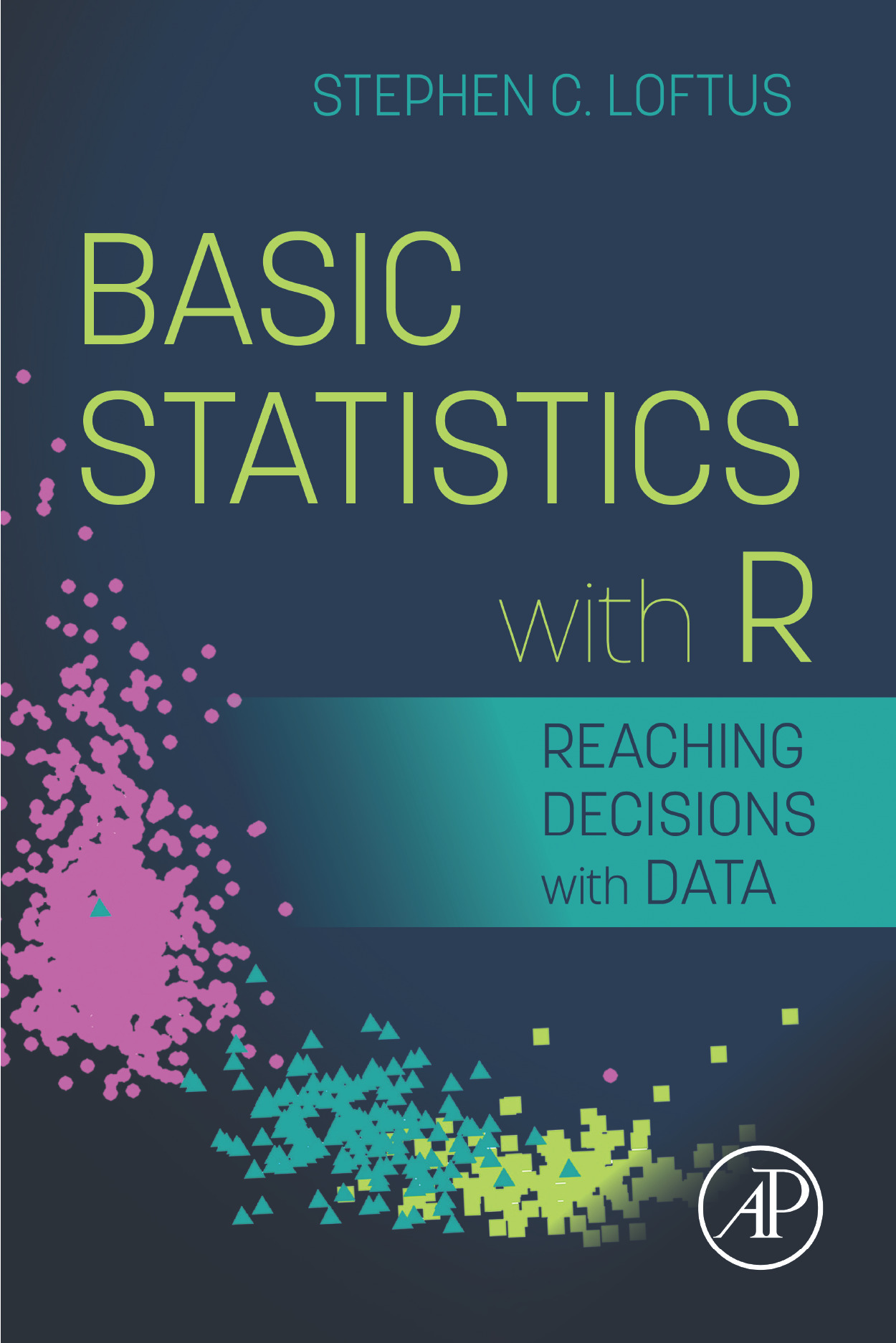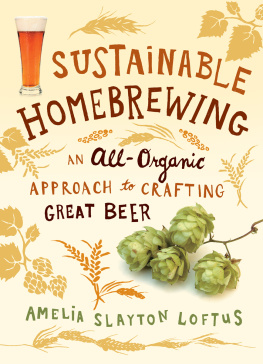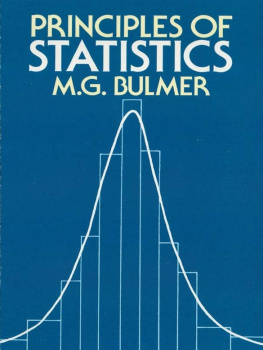Stephen C. Loftus - Basic Statistics with R
Here you can read online Stephen C. Loftus - Basic Statistics with R full text of the book (entire story) in english for free. Download pdf and epub, get meaning, cover and reviews about this ebook. year: 2021, publisher: Elsevier Science, genre: Home and family. Description of the work, (preface) as well as reviews are available. Best literature library LitArk.com created for fans of good reading and offers a wide selection of genres:
Romance novel
Science fiction
Adventure
Detective
Science
History
Home and family
Prose
Art
Politics
Computer
Non-fiction
Religion
Business
Children
Humor
Choose a favorite category and find really read worthwhile books. Enjoy immersion in the world of imagination, feel the emotions of the characters or learn something new for yourself, make an fascinating discovery.

- Book:Basic Statistics with R
- Author:
- Publisher:Elsevier Science
- Genre:
- Year:2021
- Rating:3 / 5
- Favourites:Add to favourites
- Your mark:
- 60
- 1
- 2
- 3
- 4
- 5
Basic Statistics with R: summary, description and annotation
We offer to read an annotation, description, summary or preface (depends on what the author of the book "Basic Statistics with R" wrote himself). If you haven't found the necessary information about the book — write in the comments, we will try to find it.
Basic Statistics with R — read online for free the complete book (whole text) full work
Below is the text of the book, divided by pages. System saving the place of the last page read, allows you to conveniently read the book "Basic Statistics with R" online for free, without having to search again every time where you left off. Put a bookmark, and you can go to the page where you finished reading at any time.
Font size:
Interval:
Bookmark:

First edition
Stephen C. Loftus
Division of Science, Technology, Engineering and Math, Sweet Briar College, Sweet Briar, VA, United States

- Figures in Chapter 1
- Figures in Chapter 2
- Figures in Chapter 3
- Figures in Chapter 4
- Figures in Chapter 5
- Figures in Chapter 6
- Figures in Chapter 7
- Figures in Chapter 8
- Figures in Chapter 9
- Figures in Chapter 11
- Figures in Chapter 12
- Figures in Chapter 13
- Figures in Chapter 14
- Figures in Chapter 15
- Figures in Chapter 16
- Figures in Chapter 17
- Figures in Chapter 18
- Figures in Chapter 19
- Figures in Chapter 20
Part I: An introduction to statistics and R
Outline
Part II: Collecting data and loading it into R
Outline
Part III: Exploring and describing data
Outline
Part IV: Mechanisms of inference
Outline
Part V: Statistical inference
Outline
Academic Press is an imprint of Elsevier
125 London Wall, London EC2Y 5AS, United Kingdom
525 B Street, Suite 1650, San Diego, CA 92101, United States
50 Hampshire Street, 5th Floor, Cambridge, MA 02139, United States
The Boulevard, Langford Lane, Kidlington, Oxford OX5 1GB, United Kingdom
Copyright 2022 Elsevier Inc. All rights reserved.
No part of this publication may be reproduced or transmitted in any form or by any means, electronic or mechanical, including photocopying, recording, or any information storage and retrieval system, without permission in writing from the publisher. Details on how to seek permission, further information about the Publisher's permissions policies and our arrangements with organizations such as the Copyright Clearance Center and the Copyright Licensing Agency, can be found at our website: www.elsevier.com/permissions.
This book and the individual contributions contained in it are protected under copyright by the Publisher (other than as may be noted herein).
Notices
Knowledge and best practice in this field are constantly changing. As new research and experience broaden our understanding, changes in research methods, professional practices, or medical treatment may become necessary.
Practitioners and researchers must always rely on their own experience and knowledge in evaluating and using any information, methods, compounds, or experiments described herein. In using such information or methods they should be mindful of their own safety and the safety of others, including parties for whom they have a professional responsibility.
To the fullest extent of the law, neither the Publisher nor the authors, contributors, or editors, assume any liability for any injury and/or damage to persons or property as a matter of products liability, negligence or otherwise, or from any use or operation of any methods, products, instructions, or ideas contained in the material herein.
Library of Congress Cataloging-in-Publication Data
A catalog record for this book is available from the Library of Congress
British Library Cataloguing-in-Publication Data
A catalogue record for this book is available from the British Library
ISBN: 978-0-12-820788-8
For information on all Academic Press publications visit our website at https://www.elsevier.com/books-and-journals
Publisher: Katey Birtcher
Editorial Project Manager: Alice Grant
Production Project Manager: Beula Christopher
Designer: Patrick C. Ferguson
Typeset by VTeX

To Michelle, to whom I should have listened sooner.
Dr. Stephen Loftus is a Visiting Professor of Mathematics at Sweet Briar College. Prior to this, he received a Ph.D. in Statistics from Virginia Tech and worked as an Analyst in Baseball Research and Development for the Tampa Bay Rays. His research focuses on Bayesian applications in large datasets and sabermetrics.
Stephen C. Loftus
Over the past 15 yearsever since I took AP Statistics as a high school juniorI have heard many horror stories from friends, family, and complete strangers about their experiences with statistics. It was too difficult or It just did not click for me were common refrains. As such, the thought of doing statistics or working with data fills them with fear.
This is something I consider very unfortunate, for two reasons. The first is that statistics is a subject with which I am personally fascinated. The ability to draw information out of and tell stories with data is something that has drawn me to the subject. Second, and much more importantly, the ability to work with data is becoming an essential skill in the 21st century. As the amount of data increases in every field, employees of all types are expected to take a larger part in the process of drawing decisions from this data. This cannot happen when a person's sole experience with statistics is negative.
What follows is an attempt to try to provide a minimal-stress introduction to statistics for some or a gentle reintroduction to the subject for others. In this book, we will be looking at many of the foundations of statistics; from how data is collected, to exploratory analysis, to basic statistical inference. In doing so, we will have many opportunities to practice the techniques learned through examples and practice problems.
Additionally, many of the problems posed by modern statistics require the use of software to find a solution. As such, the statistical methods taught in this book are accompanied by instruction in the statistical programming language R. While not intended to be a comprehensive introduction to either coding or R, it should provide a good starting point for individuals working in this language for the first time.
With all this in mind, let us go forward into the process of statistics.
I would like to thank everyone who helped to make this book come to fruition, to include Raina Robeva, for putting me in touch with the right people to start this project, and everyone at Elsevier who had a hand in this process, particularly Katey Birtcher, Alice Grant, Andreh Akeh, and Beula Christopher. The initial three reviewers provided helpful suggestions relating to content that could augment one's understanding. Additionally, I would like to thank all of my various math and statistics teachers, professors, and mentors who trained me to be the statistician I am today. Furthermore, I would like to thank the students at Sweet Briar who gave me cause to create this text. Finally, I must especially thank my wife, Michelle, who first suggested I turn my class notes into a textbook a full year prior to my contact with Elsevier, and also to my family for their support.
- 1.1
- 1.2
- 1.2.1
Font size:
Interval:
Bookmark:
Similar books «Basic Statistics with R»
Look at similar books to Basic Statistics with R. We have selected literature similar in name and meaning in the hope of providing readers with more options to find new, interesting, not yet read works.
Discussion, reviews of the book Basic Statistics with R and just readers' own opinions. Leave your comments, write what you think about the work, its meaning or the main characters. Specify what exactly you liked and what you didn't like, and why you think so.









